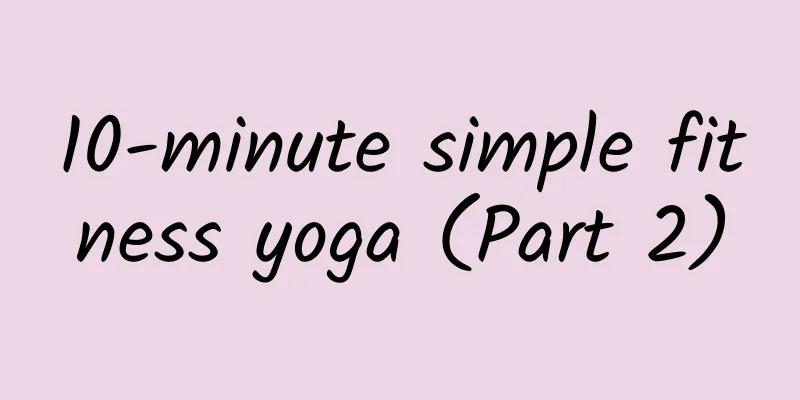10-minute simple fitness yoga (Part 2)

|
Choose the most suitable posture
In different environments, different yoga postures are suitable for practice. For example: in spacious environments such as yoga studios and outdoors, both standing and sitting and lying asanas are suitable for practice; in the bedroom at home, it is more suitable to practice sitting and lying yoga; in the office, you can use tables and chairs to assist in practicing standing asanas.
Everyone's physical condition is different, and the yoga postures that are suitable for them are also different. For example, those who suffer from dizziness and headaches can practice postures such as Head Relaxation Pose and Fish Pose to promote blood circulation in the head; those who often suffer from back pain can practice postures such as Triangle Pose and Sage Mariki Pose to stretch the waist and back; those who have stiff joints can practice postures such as Upper Right Angle Pose to help flexibly practice joints; those who often feel restless can practice Mahasthamaprapta, Salutation Pose and Inverted Arrow Pose. Three asanas that help to calm the mind and stabilize emotions; for those who suffer from insomnia, practice some asanas such as the gazing method and the cobra pose, which can help improve sleep quality; for female friends who are often troubled by menstrual pain, practice more asanas such as the grinding bean pose and the garland pose, which can promote blood circulation in the pelvic area and eliminate menstrual pain; for male friends who want to improve their sexual function, practice more tiger pose, sitting angle pose and double leg back stretch. Couples can also practice together. Suitable positions include the double swallow pose and the double V pose. Breathing and meditation are essential Yoga is centered around meditation, breathing and asanas, among which breathing and meditation are the basis of yoga practice. After a period of breathing and meditation practice, not only can the fitness effect of yoga movements be improved, but also tension can be eliminated, muscle soreness can be reduced, and the optimal state of physical and mental harmony can be achieved. To coordinate yoga breathing and movements closely, you need to master the following basic principles: you should inhale when stretching your body, and exhale when contracting and twisting your body. In the forward bending posture, you should inhale when your arms are stretched upward, and exhale when your body is bent forward. When maintaining a certain posture, do not hold your breath. Keep breathing smoothly and use breathing to make the movement more effective. For example: When the body maintains a twisting posture, the movement should be coordinated with breathing. When practicing yoga asanas, do not breathe deliberately, as this will make your body tense and affect the completion of the movements. Therefore, you must follow the principle of natural breathing and learn to control your breathing. Generally speaking, the length of your inhale and exhale should be roughly equal; if your inhale lasts 10 seconds, your exhale should also last 10 seconds. In addition, only after you have complete control and regulation over the process of inhalation and exhalation can you start practicing breath holding. Otherwise, do not hold your breath easily, especially if you suffer from heart disease or high blood pressure. Yoga breathing is mainly divided into three types: abdominal breathing, chest breathing and complete breathing:
For more exciting content, please refer to the book "10-Minute Simple Fitness Yoga" published by Hanxiang Culture. |
<<: 10-minute simple fitness yoga (Part 1)
>>: A Suzhou-style mooncake contains a lot of oil, which takes 20,000 steps to burn.
Recommend
Why does bacterial vaginosis occur?
Bacterial vaginosis may be caused by poor hygiene...
Can we still eat radishes and onions after they sprout? Nutrition experts reveal: "These" foods are more nutritious after sprouting
Many housewives have the experience of leaving ra...
Common and easily identifiable manifestations of vaginitis
Although vaginitis is a common gynecological dise...
How to treat cervicitis? Four things to note for patients with cervicitis
Excessive stress in life or other reasons can cau...
Tips on weight loss that you must know (Part 2)
Drinking soup can also make you thin and beautifu...
Home care for patients with secondary amenorrhea
Secondary amenorrhea refers to a condition in whi...
Can drinking too much coffee cause miscarriage in pregnant women? What foods can cause miscarriage in pregnant women?
The diet of pregnant women is related to the norm...
How to cure congenital absence of vagina
How to cure congenital absence of vagina? Althoug...
Cattle with clenbuterol can choose: Department of Health: mandatory labeling of origin
The "Draft Amendment to the Food Sanitation ...
What to eat for women with cervical erosion and bleeding? 12 dietary therapies for patients with cervical erosion and bleeding
In life, women with cervical erosion should be tr...
What are the methods for diagnosing cervicitis?
If cervicitis is not treated actively, it is very...
What are the prescriptions for rectal enema for pelvic effusion?
What are the prescriptions for rectal enema for p...
What's wrong with hemorrhoids? Will it affect menstruation?
What's wrong with hemorrhoids? Will it affect...
Conservative surgery is suitable for patients with ectopic pregnancy who want to have children
The so-called conservative surgery for treating e...
How to treat high prolactin? What should we pay attention to in daily life?
How to treat high prolactin? This is a question w...









